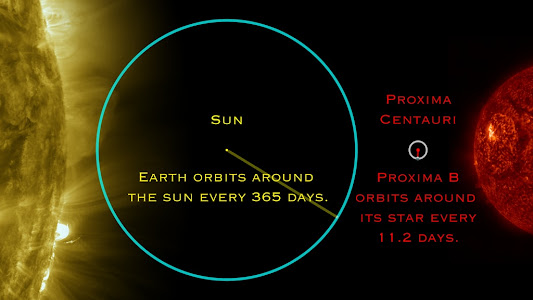Proxima Centauri b - Click Here
Proxima Centauri b: A Cosmic Neighbor in the Quest for Life
1. Characteristics of Proxima Centauri b:
- Size:
- Orbit:
- Habitability:
2. The Enigmatic Atmosphere:
While Proxima Centauri b beckons with its potential for habitability, the secrets of its atmosphere remain shrouded in cosmic mystery. Detecting and deciphering exoplanet atmospheres, particularly those as distant as Proxima Centauri b, present formidable challenges, necessitating advanced telescopes and instruments.
The atmosphere, a vital player in the habitability game, governs temperature, shields against radiation, and may cradle the essential building blocks of life.
3. The Quest for Extraterrestrial Life:
Proxima Centauri b has stirred the hearts of scientists and space enthusiasts alike in the quest for extraterrestrial life. Its proximity to Earth and placement within the habitable zone make it a prime candidate for exploration. Scientists are eager to study exoplanets like Proxima Centauri b because they offer a window into the potential for life beyond our solar system.
The search for extraterrestrial life extends far and wide, encompassing the study of exoplanets both within and outside the habitable zone. It hinges on the hunt for signs of habitability and biomarkers—indicators such as water, oxygen, and methane—within exoplanet atmospheres.
The discovery of life, if it exists, on Proxima Centauri b or any other exoplanet would be an epochal scientific achievement, reshaping our understanding of life's prevalence in the universe.
4. A Comparative Gaze at Proxima Centauri b and Earth:
To appreciate Proxima Centauri b fully, let's draw parallels between it and our beloved Earth:
- Size and Mass:
Proxima Centauri b: Earth-sized and terrestrial in nature, with a mass about 1.3 times that of Earth.
- Parent Star and Orbit:
Proxima Centauri b: Dances around Proxima Centauri, a red dwarf star, in an orbit just over 7.5 million kilometers from its host star, completing an orbit in 11.2 Earth days.
- Habitability and Atmosphere:
Proxima Centauri b: Conceals its atmospheric secrets, awaiting the advances of science to unveil its composition and properties.
- Potential for Extraterrestrial Life:
Proxima Centauri b: Nestled within the habitable zone, sparking the imagination with the potential for life, while the existence of life on the exoplanet remains speculative, awaiting further research.





Comments
Post a Comment